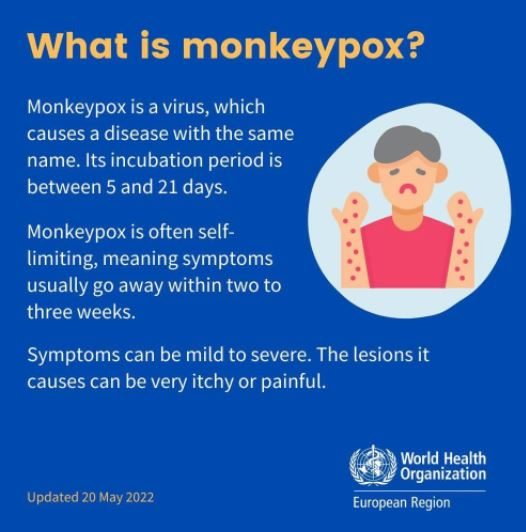WHO working closely with countries responding to monkeypox
WHO and partners are working to better understand the extent and cause of an outbreak of monkeypox. The virus is endemic in some animal populations in a number of countries, leading to occasional outbreaks among local people and travelers. The recent outbreaks reported across 11 countries so far are atypical, as they are occurring in non-endemic countries.
Monkeypox is a disease caused by the monkeypox virus. It is a viral zoonotic disease, meaning that it can spread from animals to humans. It can also spread between people. The disease is called monkeypox because it was first identified in colonies of monkeys kept for research in 1958. It was only later detected in humans in 1970.
World Health Organization
There are about 80 confirmed cases so far, and 50 pending investigations. More cases are likely to be reported as surveillance expands.

WHO is working with the affected countries and others to expand disease surveillance to find and support people who may be affected, and to provide guidance on how to manage the disease. We continue to convene meetings of experts and technical advisory groups (such as the meeting today of the Strategic & Technical Advisory Group on Infectious Hazards with Pandemic and Epidemic Potential [STAG-IH]) to share information on the disease and response strategies.
WHO continues to receive updates on the status of ongoing outbreaks in endemic countries.
Monkeypox spreads differently from COVID-19. WHO encourages people to stay informed from reliable sources, such as national health authorities, on the extent of the outbreak in their community (if any), symptoms and prevention.
As monkeypox spreads through close contact, the response should focus on the people affected and their close contacts. People who closely interact with someone who is infectious are at greater risk for infection: this includes health workers, household members and sexual partners.

Stigmatizing groups of people because of a disease is never acceptable. It can be a barrier to ending an outbreak as it may prevent people from seeking care, and lead to undetected spread.
As the situation is evolving, WHO will continue to provide updates we learn more.





